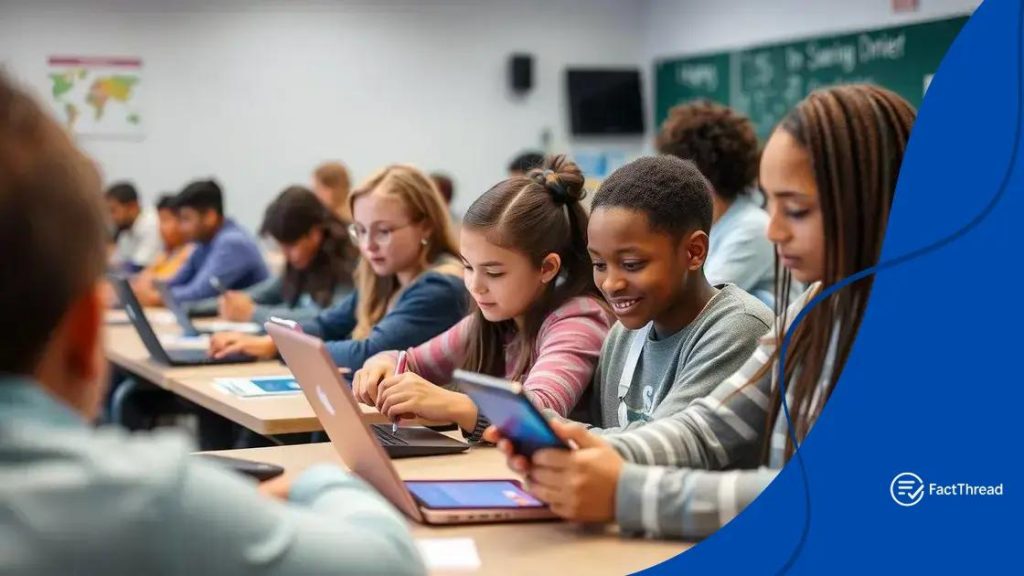Digital divide in education highlighted: Bridging gaps

The digital divide in education highlights the gap between students with access to technology and those without, impacting learning equity and necessitating targeted strategies to ensure all students have equitable educational opportunities.
Digital divide in education highlighted often brings to mind disparities that affect students’ learning experiences. Have you considered how unequal access to technology shapes educational outcomes? In this article, we dive deep into this pressing issue.
Understanding the digital divide
Understanding the digital divide is crucial in our modern world, especially in education. It refers to the gap between those who have easy access to digital technology and those who do not. This disparity can greatly affect students’ abilities to learn and succeed in their studies.
The digital divide can be viewed through various lenses, including geographic, economic, and social factors. For instance, rural areas may lack adequate internet infrastructure, making it difficult for students to engage in online learning. On the other hand, low-income families might struggle to afford necessary devices like laptops or tablets.
Key Factors Contributing to the Digital Divide
Several key elements contribute to this divide:
- Access to Technology: Many students do not have access to computers or reliable internet at home.
- Economic Disparities: Families with lower incomes often cannot afford the technology needed for effective learning.
- Geographic Barriers: In rural areas, internet connectivity can be limited or non-existent.
- Educational Inequities: Some schools are better equipped with technology than others, creating unequal opportunities.
Moreover, the digital divide extends beyond just having access to devices. It also involves the ability to use them effectively. Students need digital literacy skills to succeed in an increasingly tech-driven education system. Without these skills, even those with access may struggle to keep up.
Impacts of the Digital Divide
The effects of this divide are serious. Students without proper access to technology may fall behind in their studies, leading to educational inequities that can last a lifetime. This can hinder their ability to pursue higher education and ultimately impact their career opportunities. Additionally, as the world becomes more dependent on technology, those on the wrong side of the digital divide may find themselves at a significant disadvantage.
In summary, understanding the digital divide provides insight into the challenges faced by many students today. Addressing these gaps is essential for ensuring that all children have the opportunity to succeed, regardless of their background or circumstances.
Impacts of the digital divide on students
The impacts of the digital divide on students can be profound and far-reaching. These gaps in access to technology significantly affect educational experiences and outcomes. When students lack access to essential digital tools, their ability to engage in learning diminishes, and opportunities for academic growth become limited.
Access to online resources is becoming increasingly essential for success in education. Those who cannot connect to the internet miss out on valuable information and learning materials. In today’s learning environment, being unable to access educational platforms can lead to setbacks in understanding important topics.
Effects on Academic Performance
The academic performance of students is directly influenced by their access to technology. Students without access may:
- Struggle with assignments: Without reliable internet, completing homework can become challenging.
- Miss collaborative opportunities: Group projects often require online communication and shared resources, which can be difficult without access.
- Have lower grades: Limited access to learning resources can result in poor understanding and lower overall grades.
Moreover, the social impacts can be just as damaging. Students who are on the wrong side of the digital divide may feel isolated from peers. They might miss out on collaborative learning and extracurricular activities that rely on technology, leading to feelings of exclusion.
Long-Term Consequences
In the long run, the digital divide can have serious implications for a student’s future. Without proper access and skills, students may find it challenging to pursue higher education or tech-based careers. This creates a cycle of inequality that persists through generations.
Ultimately, addressing the impacts of the digital divide is critical for fostering equitable educational opportunities. It ensures that every student has the chance to succeed in a world that increasingly values digital literacy and technological proficiency.
Strategies to bridge the educational gap

Finding effective strategies to bridge the educational gap caused by the digital divide is essential for fostering equitable learning environments. Schools and communities must work together to ensure that every student has access to the resources they need to succeed.
One approach to bridging this gap is to increase access to technology. Schools can offer loans or rentals for laptops and tablets to families in need. This helps students complete assignments and participate in online learning effectively. Additionally, ensuring that all students have reliable internet access is crucial. Initiatives like community Wi-Fi hotspots can provide connectivity where needed.
Promoting Digital Literacy
Beyond just providing devices, promoting digital literacy is vital. Programs can be established to teach students how to use technology effectively. These skills are needed for navigating online platforms, conducting research, and completing digital assignments. Schools can offer workshops to teach both students and parents about using technology.
- Workshops for Students: Regular sessions that teach skills such as online research techniques, coding, or using educational software.
- Parental Involvement: Helping parents understand technology so they can assist their children at home.
- Peer Mentorship: Older students or tech-savvy classmates can help younger ones learn how to use devices and online tools.
Another significant strategy is building partnerships with community organizations. Local businesses and nonprofits can provide resources and expertise to support educational initiatives. These partnerships can offer tutoring programs or after-school activities that focus on technology use and digital skills.
Creating Inclusive Curricula
Lastly, schools should focus on creating inclusive curricula that consider the diverse needs of all students. This can include integrating technology into traditional subjects, ensuring that lessons are accessible to students with varying digital skill levels. By tailoring lessons and resources, educators can create a more balanced learning experience for everyone.
Implementing these strategies takes commitment and collaboration, but they are essential for promoting equity in education. Bridging the educational gap requires collective effort from schools, families, and communities to ensure that every student has the opportunity to thrive in a tech-driven world.
Role of technology in education equity
The role of technology in education equity is becoming increasingly important as we strive for a fair learning environment. Technology has the potential to level the playing field for students from different backgrounds. By integrating tech tools in the classroom, educators can help all students access the same resources.
One major benefit of technology is its ability to deliver personalized learning experiences. Students can learn at their own pace through online courses and educational software. This flexibility can be crucial for those who may struggle in a traditional classroom setting. Additionally, technology allows for diverse learning styles to be accommodated, ensuring that visual, auditory, and kinesthetic learners can thrive.
Access to Resources
With technology, students gain access to a wealth of information that was previously unavailable to them. Online libraries, educational websites, and interactive learning platforms provide materials that enrich the learning experience. Ensuring equitable access to these resources is vital for promoting education equity.
- Digital Libraries: Students can explore countless books and articles from anywhere.
- Online Courses: These offer opportunities to learn skills not available in their local schools.
- Virtual Tutoring: Additional support can help students who need extra assistance.
Furthermore, technology enhances communication between educators, students, and parents. Platforms like educational apps and websites provide channels for updates on student progress. These tools keep families involved and informed, which is essential for supporting students’ success.
Building Collaboration
Technology also fosters collaboration among students. Group projects can now take place virtually, enabling students from different backgrounds to work together. This interaction is important for developing social skills and understanding diverse perspectives. By using collaborative tools, students can learn from each other’s experiences, building a community that values inclusivity.
Ultimately, the role of technology in education equity serves to empower students and create environments where everyone has a chance to succeed. Bridging the gap between those with and without access to technology is essential for a fair and inclusive education system.
Future implications for educational policies
The future implications for educational policies are significant as we address the digital divide in education. Policymakers must consider how technology impacts learning and equity among students. A shift towards more inclusive policies can help ensure that all students have access to the resources they need.
One major implication is the need for increased funding for technology in schools. As more educational materials move online, investment in digital tools becomes essential. Schools will need updated computers, software, and reliable internet access to keep pace with educational demands. Additionally, professional development for teachers in using technology effectively is crucial. Educators must be equipped with the skills to utilize new tools in their teaching practices.
Integrating Technology into Curricula
Another important aspect is integrating technology into curricula. Educational policies should promote the use of technology in everyday learning. This can involve adopting blended learning models that combine traditional classroom teaching with online resources. By doing so, students can benefit from various learning styles that enhance their understanding.
- Curriculum Design: Programs should be designed to foster digital skills along with traditional subjects.
- Assessment Methods: New forms of assessment that include digital projects can provide a more comprehensive view of student learning.
- Equity in Access: Policies must ensure that all students have equal access to technology and the internet.
As we look to the future, it is also important to focus on student data privacy. With an increase in technology use comes the responsibility to protect students’ personal information. Comprehensive policies are necessary to ensure that students’ data is secure and used ethically.
The Role of Community Engagement
Furthermore, community engagement will play a vital role in shaping educational policies. Schools should collaborate with local organizations, businesses, and families to support technology initiatives. This partnership can enhance resources available to students and create a sense of shared responsibility for education in the community.
In summary, the future implications for educational policies are closely tied to bridging the digital divide. By focusing on funding, curriculum integration, data privacy, and community involvement, we can create a more equitable education system for all students.
| Access to Tech | Ensure all students have essential technology for learning. |
| Digital Literacy | Teach students to effectively use technology and online resources. |
| Community Involvement | Engage local organizations for support and resources. |
| Student Data Privacy | Implement strict policies to protect student information. |
| Inclusive Policies | Create educational policies that support all students’ needs. |
FAQ – Frequently Asked Questions about the Digital Divide in Education
What is the digital divide in education?
The digital divide in education refers to the gap between students who have easy access to technology and the internet and those who do not, affecting their learning opportunities.
How can technology improve education equity?
Technology can improve education equity by providing all students with access to the same learning resources and personalized learning experiences, regardless of their background.
What strategies can help bridge the educational gap?
Strategies include increasing technology access, promoting digital literacy, and engaging community organizations to support educational initiatives.
What are the implications for future educational policies?
Future educational policies should focus on funding for technology, integrating tech into curricula, ensuring data privacy, and fostering community involvement to support equitable education.